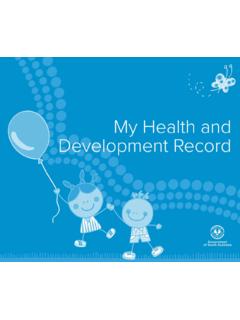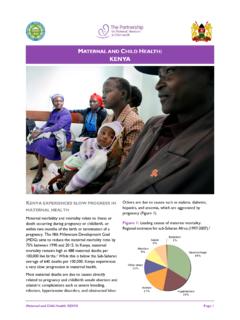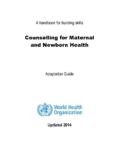Transcription of My Baby has Congenital CMV Disease: The Newborn
1 1 Vol. 6, No. 1 Spring 1998 Vol. 4 No. 1 CMV UPDATES My baby has Congenital CMV disease : The Newborn Editor's note. This article is part of a series of articles to provide practical information for parents, physicians, and other health care professionals caring for infants and children with Congenital CMV infection and disease . This first article will explain the symptoms of Congenital CMV infection in the Newborn and provide suggestions for specialty consultations, laboratory tests, and imaging studies that may be helpful.
2 Subsequent articles will focus on age-specific, long-term, follow-up issues, including nutrition, development, vision, hearing, education and social issues. Reprints of the articles in this series can be obtained from The National Congenital CMV disease Registry. How common is Congenital CMV infection? Of the estimated 4 million births annually in the United States, approximately one percent of these babies will be born with a Congenital CMV infection, making it the most common Congenital infection in humans. About ten percent of congenitally infected babies will be symptomatic (have symptoms) at birth, and many will suffer some kind of permanent disability. The remaining ninety percent of congenitally infected babies will be asymptomatic (have no symptoms) and appear normal at birth.
3 However, up to fifteen percent of these infants who appear symptom-free at birth may have permanent disabilities, the most common of which is progressive hearing loss. What are the signs and symptoms of Congenital CMV disease ? Signs and symptoms of Congenital CMV infection that can be observed at birth include microcephaly (small head size), small for gestational age (small body size), petechiae (little red spots under the skin), purpura (larger purple spots under the skin), hepatosplenomegaly (enlarged liver and spleen), jaundice (yellow color of skin and eyes), thrombocytopenia (low count of platelets in blood), pneumonia, seizures, hyper- or hypotonia (abnormally high or low muscle tone), intracranial calcifications (calcium deposits in the brain), chorioretinitis (inflammation of the back of the eye that can cause blindness), and deafness.
4 Your baby may have one or more than one of these signs or symptoms. How do you make the diagnosis of Congenital CMV infection or disease ? The diagnosis of Congenital CMV infection is confirmed by isolating (growing) the virus from urine, saliva, blood, or tissue that is collected during the baby 's first three weeks of life. Urine usually is tested because it contains the highest concentration of the virus. A positive viral culture collected beyond the three-week period but within the first year of life is considered a possible Congenital CMV infection, but also may be an acquired CMV infection from blood transfusions, mother's breast milk or birth canal secretions. If the baby 's hospital does not have the capability to grow viruses like CMV, then a urine sample, kept cool at refrigerator temperature, may be sent by mail to a reference laboratory for testing.
5 The use of blood tests, such as CMV IgG and IgM antibody levels, are not recommended for the specific diagnosis of Congenital CMV infection because only up to one half of infants with proven Congenital CMV infection will have a positive CMV IgM antibody titer, and many newborns will have a positive CMV IgG antibody titer from blood passed to them from their mother and not actually be congenitally infected with the virus. When a diagnosis of Congenital CMV infection has been made, what type of evaluation is recommended? As with any Newborn , a thorough physical examination by a pediatrician or family physician is advised. The physical examination should note the baby 's weight, length, and head size. Up to one-half of babies with Congenital CMV disease may be small for their gestational age and the presence of a small head size (microcephaly) suggests the Newborn may develop developmental disabilities later.
6 The size of the internal organs, liver and spleen, should be noted. The presence or absence of skin lesions (petechiae or purpura) also should be noted. A thorough neurologic examination to look for abnormalities in muscle tone, as well as the presence of seizures or abnormal Newborn reflexes also is an important part of the baby 's physical examination. Laboratory tests also should be performed in all infants born with Congenital CMV disease . These tests include a complete blood count and platelet count, tests for CMV hepatitis and jaundice (including total and direct bilirubin levels and transaminase levels), and a urine for CMV culture. If there are problems with breathing or respiration, then a chest radiograph (x-ray) may be performed to check for pneumonia or enlarged heart.
7 Other studies that are recommended include an unenhanced CT scan of the head to visualize the brain structures and to detect the presence of calcium deposits (intracranial calcifications) in the brain, a hearing test called an auditory brain stem evoked response (ABER) to detect deafness, and an examination of the eyes by an ophthalmologist (eye doctor) to detect chorioretinitis (inflammation of 2 the back of the eye) or other abnormalities that can produce vision loss. Studies that usually do not provide useful or specific information for the routine management of infants with Congenital CMV disease include CMV antibody tests on the blood of the Newborn or other forms of "TORCH" titers, radiographs (X-rays) of the long bones and skull, or CMV DNA tests such as PCR.
8 Imaging studies of the head such as MRI scans or ultrasound examinations, while useful for many diseases in newborns, are not the most sensitive or specific tests for calcium deposits seen in Congenital CMV disease of the brain. Can Congenital CMV infection or disease be treated? If your baby has serious disease , such as pneumonia, that may cause difficulty breathing, viral sepsis that may cause shock, or bleeding from a very low platelet count, support in a neonatal intensive care unit may be necessary. Treatment for these conditions include mechanical ventilation (breathing machine), extra fluids and medications to support blood pressure, and platelet transfusions. Most infants with Congenital CMV disease , however, are only mildly to moderately ill at birth and do well in a Level II nursery.
9 If your baby has severe jaundice and hepatitis due to CMV, medications may be given to help the liver "clear" the bilirubin levels. If your baby 's blood count or platelet count is low, then transfusions may be given. Careful attention should be given to nutritional needs, since many babies with Congenital CMV disease are small for gestational age and therefore already malnourished at birth. Clinical research trials are being conducted nationwide to see if specific antiviral treatment with drugs such as ganciclovir helps babies with severe disease at birth due to CMV infection. You or your doctor may contact the National Congenital CMV disease Registry for the names of participants near you who are conducting these research treatment trials.
10 Is special isolation required in the hospital since my baby has an infection with a virus? Standard universal hospital precautions are recommended. Special isolation is not necessary. Since CMV is spread by intimate or close contact with infectious secretions, such as saliva or urine, careful hand washing after exposure to a CMV infected Newborn is very important for everyone, but especially for pregnant women. Study Participants Wanted Neonates wanted for Congenital CMV disease Treatment Trial Babies are still needed for enrollment into the CASG (Collaborative Antiviral Study Group) Phase III Study to evaluate the safety and efficacy of ganciclovir (DHPG. To be considered for enrollment, a baby must present with Congenital CMV disease with CNS involvement, be screened for enrollment before 28 days of age, and have a positive CMV culture.)







